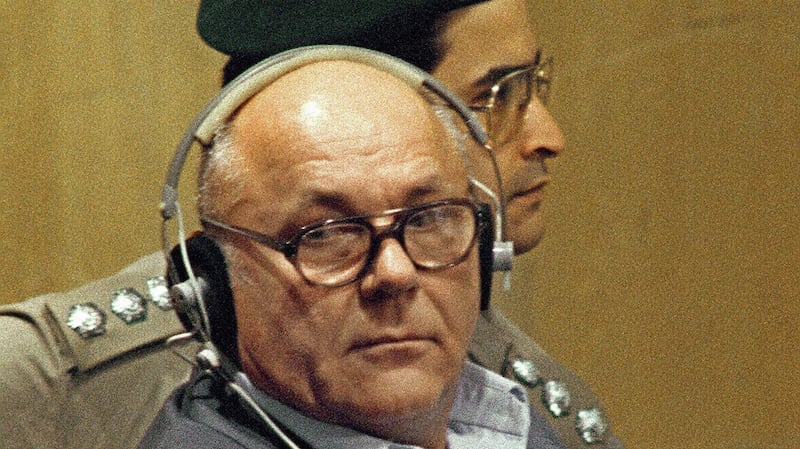When he was writing his recent novel The Zone of Influence Martin Amis filtered his preoccupation with the Holocaust through one of its less commonly discussed dimensions: the logistical headache the German state faced when it tried to exterminate the Jewish race. Likewise Lawrence Douglas, himself a sometime novelist as well as a professor of law, here hones in on another of the Holocaust's thorny peripheral facets: the legal entanglements that arose in decades after the second World War, as Germany and the wider world sought to apportion guilt for a crime of a kind never seen before.
Dense and legally minded, his book will be of particular interest to those for whom the law is a passion or a profession; lay readers may struggle to hack through the jurisprudential thicket. Through a close analysis of the evolutions and the challenges faced by the legal systems of Europe, Israel and the United States in the effort to prosecute former Nazis and concentration-camp workers, Douglas probes broader issues of culpability in state-sanctioned crimes.
The book’s nucleus is John Demjanjuk, a poor rural Everyman from Ukraine, that “miserable corridor” of Eastern Europe’s 20th century, caught between “the forced famines of Stalin and the genocidal politics of Hitler”. Drafted into the Red Army at the start of the second World War, Demjanjuk was captured as a POW by the German army, trained in the administration of concentration camps at Trawniki, and sent to work as a guard at Sobibor, a “pure killing centre” where Jews by the thousands were transported for immediate mass murder in the gas chambers.


After the war Demjanjuk emigrated to the United States by exploiting its Displaced Persons Act of 1948, which involved fudging his wartime activities on official documentation.
Decades later, in 1975, the process began that would lead to Demjanjuk’s becoming the subject of the longest legal case involving Holocaust crimes. It was not until 2011 that Demjanjuk, then an octogenarian in deteriorating health, was convicted in a Munich court for facilitating the murder of more than 28,000 Jews. Controversially, he was released from jail pending his appeal, and lived out his final five months in a care home.
Douglas argues that Demjanjuk’s conviction was nonetheless of immense symbolic, legal and moral importance. It has effected a deep legislative shift, he says, bestowing culpability on the passive facilitators of genocide rather than exclusively on those who distinguished themselves through excess cruelty. There is no claim to innocence for cogs in a death machine: “guilt follows function. Such was the simple, terrible, and great insight of these courts.”
Historic conviction
Before this historic conviction could come about Demjanjuk had already endured decades of international legal wrangling. In the 1970s and 1980s he was subjected to denaturalisation proceedings in the US. (He had made his home in suburban Cleveland.) Then, in 1986, he was forcibly removed to Jerusalem, where, in a notorious case of mistaken identity, he stood accused of the crimes committed by a vicious death-camp sadist known as Ivan Grozny –- Ivan the Terrible.
The Jerusalem trial is the centrepiece of The Right Wrong Man. Douglas teases out its historical significance through a series of contrasts and parallels with the 1960 trial of Adolf Eichmann. Eichmann was dramatically captured by Israeli secret services in the suburbs of Buenos Aires, transported to Israel, and hanged after being found guilty in "the great Holocaust trial".
As well as holding to account one of the bureaucrat-architects of the Final Solution, the Eichmann trial was a spectacle of nation-bonding “didactic legality”. Faced with a new generation worryingly ignorant of the “unspeakable horror, the unmasterable trauma” of the Holocaust, the trial was intended to give the victims a chance to recount their experiences in the Nazi concentration camps.
It also jolted the people of Israel into recognising the existential threat faced by the Jewish race, and its consequent need for vigilance and aggression.
Demjanjuk’s trial, it was hoped, would provide a fresh opportunity for Holocaust didacticism, before the era had passed when the victims and perpetrators were still around to speak their truths. Still, it was a surprise to many when it became a national sensation. Despite his insistence that they had got the wrong man, Demjanjuk was eventually found guilty and sentenced to death.
Before he was hanged, however, evidence appeared indicating that he really had been mistaken for another Ukrainian – an extravagantly cruel guard at the Treblinka camp. This real “Ivan Grozny” was known to hack off prisoners’ ears and noses with a sword, even as he herded them into the gas chambers for a death already saturated in horror.
Startling statistics
Although Demjanjuk was acquitted, his notoriety after the Jerusalem trial eventually led to his being tried again, in Munich – not for wantonly sadistic acts but for facilitating mass murder while serving as a death-camp guard.
Before the account of that final trial – Douglas compares it to a David Foster Wallace novel: “hopelessly digressive, difficult to follow, largely unplotted, needlessly long, and tediously repetitive” – the eternally awful details of what was perpetrated at the Nazi camps are rehearsed.
With Treblinka and Belzec, Sobibor was one of the death camps built at remote, hidden sites as part of Aktion Reinhard, the code name of the secret Nazi plan to murder Poland’s Jews. (Later, as the final solution intensified, the camps were used for the killing of a more indiscriminately sourced quotient of European Jewry.) Statistics can reduce the agonies of history to abstractions, but in this case they are startling. Of the Jews “resettled” to the Aktion Reinhard killing centres, 99.999 per cent were killed, most of them within hours of arrival – that is, of the 1.5 million Jews brought to the three camps on trains, no more than 120 survived.
For a novelist, Douglas pays relatively little regard to the human intimacies of his story. (Demjanjuk, admittedly, appears to have been a fairly uninteresting character: a “cheerful palooka”, according to Philip Roth, who attended the Jerusalem trial.) He opts instead to zoom in on the judicial details: this is a story of the law more than the law’s subjects. For some chapters Demjanjuk is almost entirely offstage. The reader is obliged to take a deep breath and plunge into prose opaque with legal arcana (sample sentence: “To make sense of this regrettable development, we need to return to Control Council Law No. 10”). Still, a good deal of ground is authoritatively covered here, and the account of Demjanjuk’s legal odyssey and the judicial systems that manoeuvred themselves around him feels definitive.
Rob Doyle’s second book, This Is the Ritual, is published by Bloomsbury and Lilliput Press

